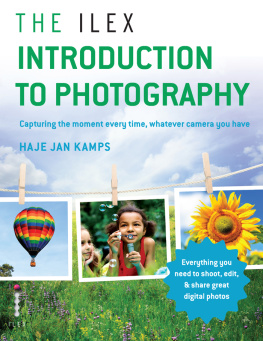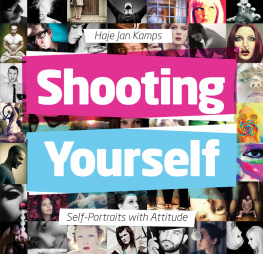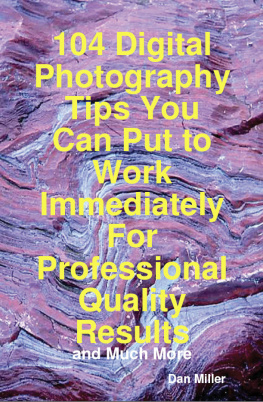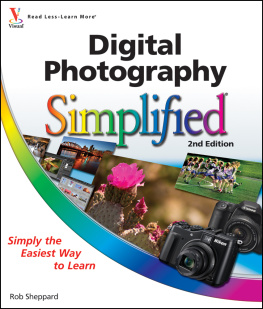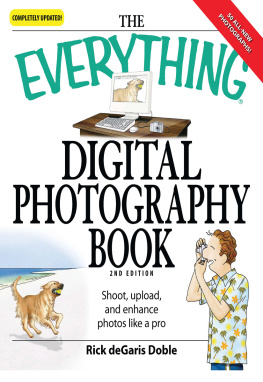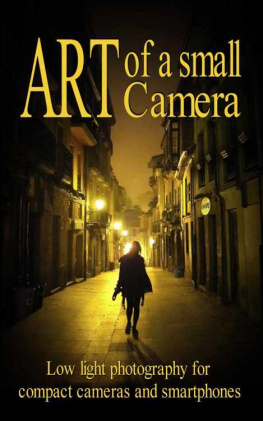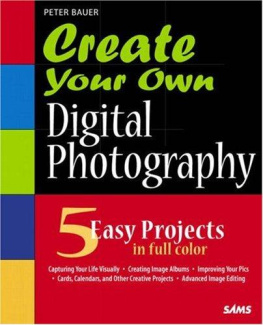
THE ILEX
INTRODUCTION
TO PHOTOGRAPHY
Capturing the moment every time, whatever camera you have

HAJE JAN KAMPS
I L E X
This is the easy guide to turning everyday snapshot photos into great pictures that youll want to keep and share. By understanding the basics of how your camera works, and the few simple rules that make photos work, youll soon find your own pictures filling with life and character.
Shoot with confidence, with your smartphone or digital camera
Understand the simple principles that will give your pictures energy and colour
Capture the personalities of your friends and family, and share their best moments with the world
CONTENTS
INTRODUCTION
Hello and welcome to the Introduction to Photography! Over the following pages were going to make a fantastic journey through the world of photography, and Im very happy that youve decided to come along!
Before we get started, Id like to dispel two myths right off the bat, if you dont mind. The first one is that you need very high-end equipment in order to be able to take good photos. Nothing could be further from the truth. Sure there are occasions where a fancy camera might make your job easier, and there are indeed certain techniques that are impossible unless your camera has certain features, but on the whole, you really dont need to spend all that much money to hugely improve your photography.
The other myth is that photography requires a good eye or natural talent. Hogwash. Getting started from the very beginner levelwhere you are right nowis easy. Once youve got to grips with the basics youll find there are loads of very simple ways to drastically improve your shots, and this book is full of tips that will help you to progress quickly. Further down the line when you start getting the hang of things, you may find that in order to reach the next level you need to start developing an eye for photography, but the secret not a lot of photographers will tell you is this: As soon as you realize that you want to start developing your own style, and training your eye for composition, youre already halfway there.
My number one top tip to becoming a better photographer is to be self-critical. Take a lot of photos, all the time. Use the camera built into your phone, take a compact camera with you everywhere you can, and dig out a bigger camera (if you have one) as often as possible. In the beginning, you may find that only one in a thousand photos is any good. But look on the bright side: If you take a thousand photos, youll get at least one fantastic picture!
With practice, the tricks shown in this book, and a good idea of what all the buttons and dials on your camera do, you can start working on improving that ratio of good-to-bad shots: taking it from one in a thousand, to one in a hundred, to one in ten. Yes, its a lot of work, but its incredibly rewarding, and I promise youll have a lot of fun along the way.
So what are you waiting for? Grab your camera, flip the page, and lets get started!
Haje Jan Kamps

CHAPTER 1
EQUIPMENT

Its quite ridiculous how often discussions about photography can degenerate into Mines bigger than yours-style conversations. Its doubly curious because, in our experience, among amateurs, the people with the most extravagant equipment often have the least clue about how to use it.
On the other hand, you are going to need equipmentif theres one way to guarantee youll not capture a single good photo, its by not having a camera with you!
Frequently, the most experienced photographers, who have dabbled with all sorts of high-end cameras, find themselves turning back to relatively simple equipment. This means that if you want to be a better photographer, you really shouldnt worry too much about your equipment. Worry about the person holding the camera. Work on becoming a better photographer, and your photos will improve. All the camera gadgets in the world are only going to be a distraction if youre struggling with the basics.
FIXED-LENS CAMERAS
The term fixed-lens camera applies to any camera with a lens that cannot be removed from the main body of the camera. There are numerous types of fixed-lens cameras, ranging from inexpensive, mostly automatic point-and-shoot models, through bridge or superzoom cameras with powerful zoom lenses, to high-end compacts with large imaging sensors that are capable of producing photos comparable to those taken with a DSLR (digital single-lens reflex cameraexplained on the following pages).
Point-and-shoot cameras
Point-and-shoot cameras are small in size, typically have limited manual controls, and feature autofocus zoom lenses. Such cameras, often referred to as compact cameras, are very simple to operate and are designed for people who primarily want a quick-and-easy visual record of vacations, birthdays, weddings, and similar events. In bright daylight conditions, point-and-shoot cameras can provide good quality images that look sharp at up to 810 inches.
The principal drawbacks with this type of camera are the small size of the sensor and, typically, a lack of manual control. A small sensor is less efficient at gathering light, therefore in high-contrast lighting conditions (e.g., bright sunlight combined with dark shadow areas) point-and-shoot cameras will struggle to produce clean-looking or accurately exposed images. The lack of manual control also makes it difficult to shoot creativelyfor choosing focus or high-key effects, for example, which well cover later.
Bridge or superzoom cameras
So-called because they bridge the gap between compact point-and-shoot cameras and digital SLRs, bridge cameras tend to be larger and have a richer photographic feature set compared to compacts. Most offer manual controls, an incredible range of focal lengths (from wide-angle to super telephoto). In addition, unlike most point-and-shoot cameras which utilize a rear LCD screen for composing images, bridge cameras also have an electronic viewfinder (EVF) through which photos can be composed. This is an advantage in bright conditions when it can be difficult to see an LCD screen.
Bridge cameras are aimed at photographers who are keen to experiment with image making and like the convenience of having a 20x to 50x zoom in single package. Some bridge cameras can cost as much as entry-level digital SLRs and are capable of producing good-quality images up to small poster size. However, all that zoom range comes at the cost of a much smaller sensor, so bridge cameras cant cope with challenging lighting conditions, and are harder to control when it comes to creative shooting.
Large-sensor compacts
As a broad category, large-sensor compact cameras are the most recent type of fixed-lens cameras. Aimed at experienced enthusiasts, such cameras are often bought as portable backups to bulky professional equipment. These cameras offer full manual control, big imaging sensors (the same size or near to most digital SLRs) and high-quality lenses. However, the tradeoff is usually that the lens cannot zoomitsthe only way to put a large sensor in such a small body. Instead, itstypically locked at a moderate wide angle.
Next page
